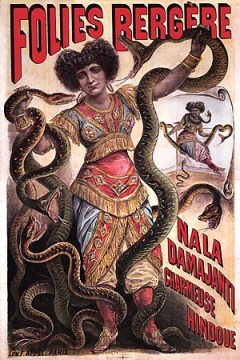
Even though Hoodoo and Conjure supplies are disseminated broadly on the internet these days, it is just as likely that one can find an actual physical botanica or spiritual store where one can purchase the essential merchandise of magical practices. These shops proliferate in urban areas throughout the United States, and more recently, we see that in the suburbs as well as some affluent neighborhoods there are places where religious and magical material goods are sold in a shopping venue. But one might view these vital institutions of Hoodoo as more than just marketplaces; consider the botanica as a museum of artifacts, a gallery of objects, a doctor’s office, and a not-so-liminal space where Interested and Curious folks can engage with experts and adherents of living cultural traditions. Think of a well-stocked botanica as an informational resource that functions on multiple levels and realms of significance: commercial, magical, and artistic.

…which brings me to the topic for today, the emergence of one of the most mysteriously ubiquitous of magical beings, the female water-spirit, Mami Wata. I say “mysteriously ubiquitous” because like many mythical forms in the African diaspora, tracking her provenance can be a special challenge. But what if we went on a journey down her visual pathways? Why not? I own a Mami Wata statuette. I keep it in my office next to my Aunt Jemima figurine, having purchased it at a deep discount at a Philadelphia botanica that was rotating its inventory of saints. Mami Wata is fascinating, not only because she appears in so many different guises across different times and places, but because as an icon she inspires multiple meanings and spiritual purposes for her devotees, who keep her presence alive.
It is as if by virtue of her fluidity as a being of the water, that she is able to shape-shift, yet somehow remain resonant with a consistent morphology. In some settings, she is simply Mami Wata – a concept originating among the Ibibio people in the southeast coast of Nigeria. Gradually, recognition of her alluring energy spread, from Togo to Tobago. In different contexts she is associated with other names; yet her deep connection to her African sources is explicit.

There, she is often presented as a goddess of fertility and healing who takes the form of a large, fish-tailed mermaid, sometimes carrying, in classic style, a mirror or a comb to groom her thick hair. In other examples she strides, queen-like, bejeweled and adorned as a mysterious woman with a serpent, the supreme avatar of divination and mystical sight, wrapped around her body. She appears throughout the African and African-American references as a personality that inspirits physical places and human bodies, but typically, she is viewed as inextricably linked to the primal forces of water: the sea, rivers, and lakes.
When I tried to trace the origins of the most widely distributed images of Mami Wata, I gained some remarkable insights into her representational diversity. In the West, artists in the late nineteenth century who were inspired by the exotic global circus performer

Nala Damajanti, captured her likeness in an image that is believed to be reproduced on the inset of a popular Bombay calendar from the 1950s. We would love to know more about other women performers who thrilled audiences with their enticing repertoire of tantric dancing and snake charming under the Orientalist gaze of the culture industry. But that is another story. As images of Nala/Mami Wata travelled, the more she inspired and enthralled, the more she adopted spectacular stylizations that were appropriate to the cultural specifics of local religious aesthetics. She makes another appearance in the Dominican Republic in early twentieth century chromolithographs as Santa Marta la Dominadora, or Saint Martha the Dominator, as she is known in espiritismo circles, an aggressive yet highly accessible female patron of domestic servants, lonely housewives, single women, and waiters. It is in this iconographic style, powerfully wielding her serpent guides as the holy child patiently sits beneath her, that the specific associations with Hoodoo practices and practitioners began to formalize. And so the circle is completed. Sources locate the history of this remarkable being in her physical, psychic, and material embodiments starting in Egypt, sweeping the African continent and on to Germany, to India, to the Caribbean, to Puerto Rico, to Brazil, and to my office at Swarthmore College, where she sits, in subtle repose, among others. As I said, she is ubiquitous, eminently popular, and profoundly multicultural. What more could one want from a wonderful water goddess?
I want this particular statue where can I find it
You can find this online search “Saint Martha the Dominator” thanks for reading!
I’m specifically looking for the kind of statue you have listed on your page. Where did you get it from where can I find it? I want the one just like the one you have in the picture
https://www.amazon.com/StealStreet-SS-G-309-90-Dominadora-Religious-Decoration/dp/B00448VLPM/ref=asc_df_B00448VLPM/?tag=hyprod-20&linkCode=df0&hvadid=192208957427&hvpos=1o1&hvnetw=g&hvrand=5215923672155011784&hvpone=&hvptwo=&hvqmt=&hvdev=c&hvdvcmdl=&hvlocint=&hvlocphy=9007225&hvtargid=pla-304810965798&psc=1. I got mine in a store in Philadelphia but they are online
Mami Wata and Papa Bois are a magnificent pair aren’t they ? Both of them stretch out in influences and manifestations in every culture on earth I bet, in one form or another. They walk the earth I think. Not just ideas, like comic-book characters, but as living entities. Mer-like and Faunesque.
Yes they are “real” and fully embodied. Papa Gran Bois is the Green Man of western occult tradition, an entity that crosses cultures and mythologies. Wonderful that these beings have returned to be active and alive in this era.
I need a good oil for Martha